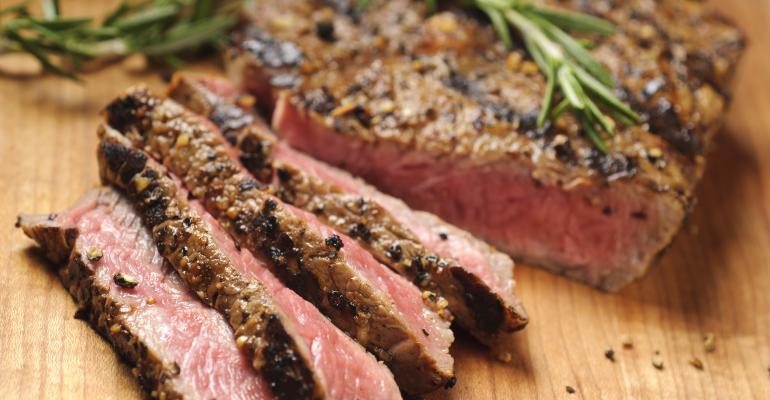Sponsored by S&D Coffee & Tea
Sometimes the most fertile sources of culinary inspiration come from staple products used in new ways --- take coffee and tea, both increasingly used to flavor food items in addition to their standard beverage roles. More foodservice operators and chefs, in fact, are exploring the versatile attributes of the bean and the leaf when it comes to creating distinctive fare.
Coffee can be found on 36 percent more entrée menus than it had been four years ago and 18 percent more over the past year, according to the Chicago-based research firm Datassential. Tea, too, is on the rise, appearing on 23 percent more entrée menus than four years ago and 14 percent more over the past year, says Datassential.
Calling on coffee. Typically, coffee is found in the kitchens of non-ethnic restaurants as a rub or in a sauce for beef and barbecue-style applications. Applied to meat, coffee can create a caramelized crust or even help to tenderize.
Tapping tea. Operators, largely in Asian restaurants, use tea to marinate, brine or smoke chicken, beef or duck. In addition, they tap green tea, particularly matcha powder, for visual effect as well as flavor in noodles, says Datassential.
Beans and beef. At South Water Kitchen, a Kimpton Restaurant in Chicago, Executive Chef Roger Waysok mixes spent grounds from the restaurant’s custom dark roast coffee blend with salt, pepper, paprika, garlic powder and other spices to flavor his signature coffee-rubbed sirloin. For an extra fillip of coffee flavor, the beef is served with a veal demi-glace sauce deglazed with espresso. “The flavors of coffee and beef fit well together as long as the coffee isn’t overpowering,” says Waysok.
He also has used coffee as a flavoring in pancake and waffle batters and as a glaze on donuts. “Sweet applications are the easy ones,” says Waysok. “Savory gets a little trickier.”
Unexpected sensations. “It’s fun to use coffee in ways that are surprising, like infusing it in olive oil,” says Mat Schuster, chef-owner of Canela Bistro & Wine Bar, a Spanish restaurant in San Francisco. He drizzles the java-tinged oil over vegetables to add unexpected flavor dimensions.
In addition, Schuster pairs dark roast coffee with cinnamon in Canela’s signature dessert, Helado Café Canela — house-made cinnamon-coffee ice cream. The robust character of the coffee counterbalances the sweet spiciness of the cinnamon.
At Departure in Denver, a modern Asian restaurant in the Sage Restaurant Group, Pastry Chef Erin Koroll reinterprets coconut ash pudding, a sweet Thai dish. One of the item’s novel flavorings is a tea-like extraction of the ashes of burnt coconut husks that Koroll likens in flavor to espresso. Another component of the dish is coffee ice cream made with a coconut milk base steeped with whole coffee beans for an hour. “It’s toasty and a little savory,” says Koroll. “The specific notes are chocolate, smoked coconut and dark roasted coffee.”
Tea’s time. Tea-inspired menu items may help operators appeal to health-minded consumers and millennials who enjoy new flavor experiences, says Scott Svihula, owner of Hula Consulting, a tea and coffee consultancy in Orlando, Fla.
Operators can use the same quality teas that appear on their beverage menus. “It’s not an added cost and you don’t have to find another supplier,” Svihula says.
Svihula suggests adding the smoky notes of Chinese lapsang souchong tea or the fruity impressions of hibiscus tea to vinaigrettes. Another suggestion is to try extracting tea in alcoholic spirits, adding it like herbs to dishes, infusing it in pasta and rice cooking water, grinding it for spice rubs, and brewing it to double or triple strength to replace the water in baking recipes.
Spots of tea. Tea-smoked duck breast is a riff on a traditional Szechwan dish at bellyQ in Chicago, a modern Asian barbecue restaurant in the Cornerstone Restaurant Group. Chef-Owner Bill Kim smokes duck breasts cured overnight with salt and Szechuan peppercorns in a wok over a smoldering mixture of equal parts Chinese gunpowder black tea, flour, sugar and rice. “You smell the tea and taste the sweetness and an almost caramelized flavor,” says Kim.
At South Water Kitchen, sweet potato fries dusted with matcha powder is an attention-getting side. “The matcha adds an earthiness that works well with the fries and goes nicely with vanilla citrus aioli dipping sauce,” says Waysok.
Future discoveries. Whether dry-rubbed onto a protein, infused into a marinade or brine or wafting fragrantly from a smoker, coffee and tea have much to offer flavor-seeking chefs and restaurateurs. Given the consumer’s continual craving for new sensations, the motivation to find new discoveries is vast.




